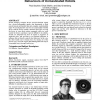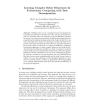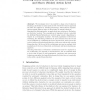95 search results - page 3 / 19 » Behavioural Cloning and Robot Control |
HRI
2009
ACM
14 years 2 months ago
2009
ACM
Several emerging computer devices read bio-electrical signals (e.g., electro-corticographic signals, skin biopotential or facial muscle tension) and translate them into computer- ...
ROMAN
2007
IEEE
14 years 1 months ago
2007
IEEE
Abstract— In this paper we provide a possible characterisation of user behaviour based on an analysis of a corpus of human-robot communication, collected by using the Wizard-of-O...
ICRA
1993
IEEE
13 years 11 months ago
1993
IEEE
A survey of blackboard robotics applications shows the improvements of blackboard models used in telerobotics and autonomous robots from the use of sequential blackboard in the ro...
EWLR
1997
Springer
13 years 11 months ago
1997
Springer
Building robots can be a tough job because the designer has to predict the interactions between the robot and the environment as well as to deal with them. One solution to cope the...
IWINAC
2007
Springer
14 years 1 months ago
2007
Springer
We investigate how it is possible to shape robot behaviour adopting a molecular or molar point of view. These two ways to approach the issue are inspired by Learning Psychology, wh...



